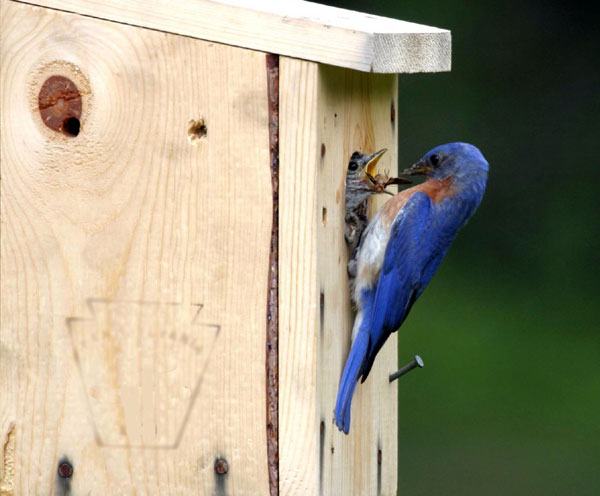Saving Bermuda’s Endangered Bluebird
 A symbol of love, hope and happiness, it is said the bluebird “carries the sky on its back and the earth on its breast” — and with its delightful warbling song and affinity for devouring grubs and caterpillars that attack our gardens, Bermuda could hardly wish for a lovelier bird to grace the island.
A symbol of love, hope and happiness, it is said the bluebird “carries the sky on its back and the earth on its breast” — and with its delightful warbling song and affinity for devouring grubs and caterpillars that attack our gardens, Bermuda could hardly wish for a lovelier bird to grace the island.
Today Bermuda’s bluebirds are critically endangered — its main threats are overdevelopment, the aggressive house sparrow competing for nest boxes and the chicken mite.
The bluebird is almost completely dependent on man for its survival. The Bermuda Bluebird Society, which falls under the auspices of the Bermuda Audubon Society, has long been encouraging local residents to erect their own backyard bluebird boxes even trails if space allows.
Bluebird boxes may be purchased from Aberfeldy Nursery in Paget The Bermuda Audubon Society will benefit from the sale of each box. Ready made boxes cost $30 and kits are $15.
The Bermuda bluebird is a member of the thrush family and bears the Latin name Sialia sialis. Bermuda is the only place outside of the eastern half of North America where it has ever been known to breed.
Throughout Bermuda’s history these bluebirds were very abundant, attaining population densities much higher than are found in the American continent. As recently as the early 1960s flocks of 50 or more bluebirds could be seen winging over the island.
Flock of bluebirds visiting the home of Ralph Richardson in February 2011
Bermuda’s bluebird population flourished when earlier settlers created more habitat by clearing woodland for open pasturelands, cropland and lawns.
The bluebird nested in holes of the shore cliffs, in walls and under the eaves of the houses, as well as in the numerous hollows provided by cedar trees.
The first and most drastic decline of the bluebird population occurred in the late 19th century when the House sparrow was introduced.
The aggressive and adaptable sparrow multiplied rapidly and soon became the most abundant bird in Bermuda. The sparrow, as a hole-nester, rapidly displaced the bluebirds from the eaves of houses and soon began taking over the cliff holes and hollow of the cedar trees as well.
By the 1930s the natural bluebird nestlings were confined almost exclusively to holes in the trunks of cedar trees. The cedar scale endemic in the late 1940′s and early 1950s killed over 90% of Bermuda’s cedar forest.
In an attempt to remove the eyesore and reforest the island the Government and private landowners felled most of the dead cedars destroying many ideal-nesting hollows.
Pesticides, the decline of habitat, other pest birds, rats, lizards, feral cats and mites also played roles in the decline of the bluebird in Bermuda.
The bluebird is now almost completely dependent on nesting boxes for their survival. Most parks and all the golf course have monitored trails. A large number of private homes also have nesting boxes.
Habitat is the key factor to consider when setting up a bluebird trail. Open grassy areas with scattered trees and low or sparse ground cover is best. Look for perch sites, such as a fence line, wires, or tree branches where bluebirds may perch to look for food.
Another shot of bluebirds converging in Mr. Richardson’s garden
Monitor the young in the nest and remove unhatched eggs or dead chicks to prevent ants from invading the nest. Trees and shrubs provide a landing spot for the young bluebirds when they first leave the box. This will keep them off the ground, away from predators.
Be sure that boxes are mounted in areas where pesticides are not used.
Boxes should be spaced at least 100 yards apart.
Check your bluebird boxes at least once a week during the nesting season. Birds do not mind being checked.
Have your bluebird boxes in place by mid-March when bluebirds are looking for nesting sites. Bluebirds nest from March until early August and are usually left alone by sparrows from July on.
They usually have two broods per season, but three broods are possible. Learn to recognise a bluebird nest — it is a tidy and neat cupshaped nest that is usually made up of 100% woven grass or casurina needles.
Bluebirds usually lay three to five light blue eggs. The incubation period for bluebird eggs is 12 to 14 days. Nestlings remain in the nest 18 to 21 days before they fledge.
Remove bluebird nests as soon as the young birds have fledged and sterilize the box with boiling water.
A sparrow nest is untidy, made up of mixed foliage and often strewn with bits of trash. Always remove sparrow nests immediately.
Keep records of the activity in your boxes. This information is valuable to the Bermuda Audubon Society, which compiles data on bluebird populations in Bermuda.
Don’t be discouraged if your nesting boxes are not used the first year. If bluebirds are not common in your area, it may take them a few seasons to find your new box.
Bluebirds generally return to the same area each year. For additional information you can write to the Bermuda Audubon Society here.
Read More About
Category: All, Environment





It’s a shame that this article was posted after the boxes are supposed to be up.
Can you post this story again with updates from Audubon Society please? It will be just in time for nesting season.